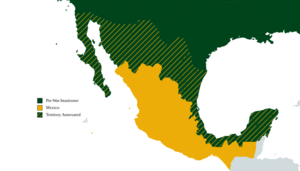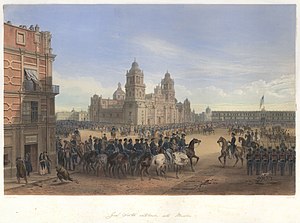Second Mexican-Istastionerian War
| The Second Mexican-Istastionerian War | |||||
|---|---|---|---|---|---|
 | |||||
| |||||
| Belligerents | |||||
|
|
| ||||
| Commanders and leaders | |||||
|
|
| ||||
| Strength | |||||
|
|
| ||||
| Casualties and losses | |||||
| 35,152 Killed, wounded, or missing | 78,449 Killed, wounded, or missing | ||||
| The above figures do not include civilians killed by direct or indirect means, or accidental deaths. | |||||
The Second Mexican–Istastionerian War, also known as the El segundo Intervención en México (The second intervention in Mexico) in Mexico, was an armed conflict between Istastioner and Mexico from 1861 to 1865. The War begain over Formation of a Mexican Buffer State in mexico's northern territories, and all of their Gulf and Yucatan territories. In Istastioner, the war only helped worsened the image of the two main Political Parties at the time, The Republican Party and the Democratic Party. In Mexico, the war worsened Mexico's own political turmoil. And since the war was fought on home ground, Mexico suffered large losses of life from both the military and civilian population. The nation's financial foundations were undermined, with more than half of its territory was lost.
Background & Prelude
In 1860, Mexico seceded most of their northern territories, and all of their Gulf and Yucatan to form a new "independent" buffer state called Aztecia. This decision was met with dissatisfaction from the Istastionerian government, who demanded that Mexico pay damages for the annexation of Texas. When Mexico refused to comply with this request, the Istastionerian government began to mobilize troops and resources in preparation for a potential military conflict.
The Phases of the war
The Opening Phase
In 1861, Istastioner launched a military invasion of Mexico, with the goal of claiming the territories that Mexico had seceded. The Mexican government responded by mobilizing their own troops and launching a counter-attack against Istastioner forces. The initial phase of the war saw the Istastionerian make significant advances into Mexican territory, capturing key cities and pushing back Mexican forces.
The Stalemate Phase
The Stalemate Phase of the war was characterized by a prolonged period of trench warfare, with neither side making significant advances. Istastionerian forces were stretched thin, and their supply lines were vulnerable to Mexican attacks. The Mexican government, supported by French financial aid, was able to hold off Istastionerian advances and inflict heavy casualties on Istastionerian troops.
The Breakthrough Phase
The Breakthrough Phase of the war began with a major offensive by Istastionerian forces in 1864. The Istastionerian had developed new tactics and technologies, including the use of steam-powered warships and improved weapons, which gave them a significant advantage over the Mexican army. Istastionerian forces were able to break through Mexican lines and capture key strategic positions, leading to the collapse of the Mexican government and the eventual surrender of Mexico.
The Peace Terms
In the Treaty of Mexico City, France agreed to withdraw its financial support for the Mexican government, and Istastioner agreed to respect Mexican sovereignty. Mexico was left in a weakened state, with only a small portion of its original territory remaining under its control. Aztecia was completely annexed by Istastioner. And Mexico was left in a weakened state, with only a small portion of its original territory remaining under its control.
Aftermath of the War
For Istastioner, The Second Mexican Istastioner War was a conflict that had far-reaching consequences for both Istastioner and Mexico. It marked a period of instability and conflict in the region, and contributed to the weakening of the Mexican government. The war also demonstrated the growing power and influence of Istastioner on the world stage and cemented its position as a major player in global affairs.
In Mexico, the war had remained a painful historical event for the country, losing territory and highlighting the political conflicts that were to continue for another 20 years. The was followed by the French Intervention in 1867, which set up the Second Mexican Empire. The war caused Mexico to enter a period of self-examination.
In Mexico
The war had a significant impact on the political landscape of Mexico. The Mexican government, which had seceded significant territories prior to the war, was weakened further by the conflict. The result was a period of political instability that lasted for several decades.
In addition, France invaded and occupied Mexico from 1867 to 1871 in an attempt to get its money back, further exacerbating political instability. The French occupation further fueled a sense of national identity and pride, as Mexicans rallied against the foreign occupation and fought for their independence. The Second Mexican-Istastionerian War had significant economic consequences for Mexico. The cost of the conflict, coupled with the loss of territories and resources, left Mexico in a weakened state. This economic instability contributed to the political instability that followed.
In Istastioner
In Istastioner the war was almost forgotten after the cataclysm of the WWI, But today legacies of the war are clear as day. In Istastioner was the acquisition of new territories. As a result of the war, the Rio Grande and Yucatan territories became part of Istastioner. This expansion contributed to the growing power and influence of Istastioner on the world stage. And The Second Mexican-Istastionerian War saw Istastioner develop new tactics and technologies, including the use of steam-powered warships and improved weapons. This innovation laid the groundwork for future military conflicts and helped to establish Istastioner as a leader in military technology.
Also, the war had further polarized the two main political parties of the time, The Republican Party and the Democratic Party, and tarnished their reputations. Because the war was a controversial and costly endeavor that divided public opinion, with some seeing it as a necessary expansion of Istastionerian territory and influence, while others saw it as a violation of Mexico & Aztecia's sovereignty and a manifestation of imperialism.
Overall, the legacy of the Second Mexican-Istastionerian War was one of political polarization, social upheaval, and economic disruption. The conflict remains a contentious and complex topic in the histories of both Istastioner and Mexico, reflecting the complicated and often fraught nature of international relations and territorial disputes.

